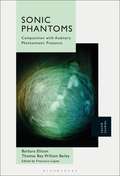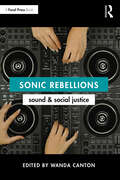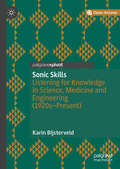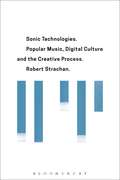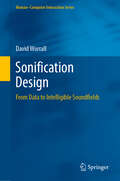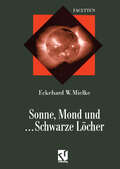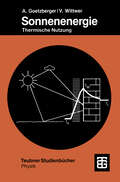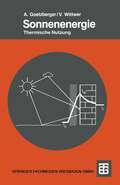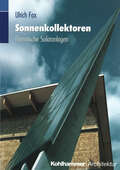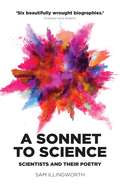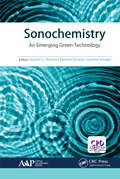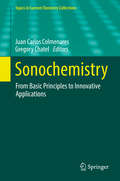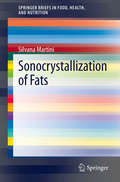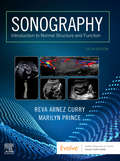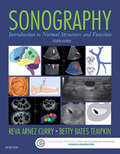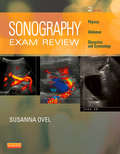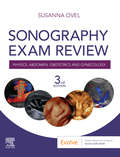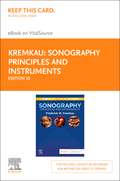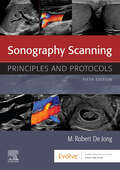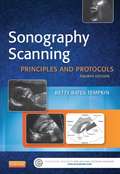- Table View
- List View
Sonic Phantoms: Composition with Auditory Phantasmatic Presence
by Barbara Ellison Thomas Bey BaileyIn this book, Barbara Ellison and Thomas B. W. Bailey lay out and explore the mystifying and evanescent musical territory of 'sonic phantoms': auditory illusions within the musical material that convey a 'phantasmatic' presence. Structured around a large body of compositional work developed by Ellison over the past decade, sonic phantoms are revealed and illustrated as they arise through a diverse array of musical sources, materials, techniques, and compositional tools: voices (real and synthetic), field recordings, instrument manipulation, object amplification, improvisation, and recording studio techniques. Somehow inherent in all music--and perhaps in all sound--sonic phantoms lurk and stalk with the promise of mystery and elevation. We just need to conjure them.
Sonic Phantoms: Composition with Auditory Phantasmatic Presence
by Barbara Ellison Thomas Bey BaileyIn this book, Barbara Ellison and Thomas B. W. Bailey lay out and explore the mystifying and evanescent musical territory of 'sonic phantoms': auditory illusions within the musical material that convey a 'phantasmatic' presence. Structured around a large body of compositional work developed by Ellison over the past decade, sonic phantoms are revealed and illustrated as they arise through a diverse array of musical sources, materials, techniques, and compositional tools: voices (real and synthetic), field recordings, instrument manipulation, object amplification, improvisation, and recording studio techniques. Somehow inherent in all music--and perhaps in all sound--sonic phantoms lurk and stalk with the promise of mystery and elevation. We just need to conjure them.
Sonic Rebellions: Sound and Social Justice
by Wanda CantonSonic Rebellions combines theory and practice to consider contemporary uses of sound in the context of politics, philosophy, and protest, by exploring the relationship between sound and social justice, with particular attention to sonic methodologies not necessarily conceptualised or practiced in traditional understandings of activism.An edited collection written by artists, academics, and activists, many of the authors have multidimensional experiences as practitioners themselves, and readers will benefit from never-before published doctoral and community projects, and innovative, audio-based interpretations of social issues today. Chapters cover the use of soundscapes, rap, theatre, social media, protest, and song, in application to contemporary socio-political issues, such as gentrification, neoliberalism, criminalisation, democracy, and migrant rights. Sonic Rebellions looks to encourage readers to become, or consider how they are, Sonic Rebels themselves, by developing their own practices and reflections in tandem to continue the conversation as to how sound permeates our sociopolitical lives.This is an essential resource for those interested in how sound can change the world, including undergraduates and postgraduates from across the social sciences and humanities, scholars and instructors of sound studies and sound production, as well as activists, artists, and community organisers.
Sonic Rebellions: Sound and Social Justice
Sonic Rebellions combines theory and practice to consider contemporary uses of sound in the context of politics, philosophy, and protest, by exploring the relationship between sound and social justice, with particular attention to sonic methodologies not necessarily conceptualised or practiced in traditional understandings of activism.An edited collection written by artists, academics, and activists, many of the authors have multidimensional experiences as practitioners themselves, and readers will benefit from never-before published doctoral and community projects, and innovative, audio-based interpretations of social issues today. Chapters cover the use of soundscapes, rap, theatre, social media, protest, and song, in application to contemporary socio-political issues, such as gentrification, neoliberalism, criminalisation, democracy, and migrant rights. Sonic Rebellions looks to encourage readers to become, or consider how they are, Sonic Rebels themselves, by developing their own practices and reflections in tandem to continue the conversation as to how sound permeates our sociopolitical lives.This is an essential resource for those interested in how sound can change the world, including undergraduates and postgraduates from across the social sciences and humanities, scholars and instructors of sound studies and sound production, as well as activists, artists, and community organisers.
Sonic Skills: Listening for Knowledge in Science, Medicine and Engineering (1920s-Present)
by Karin BijsterveldIt is common for us today to associate the practice of science primarily with the act of seeing—with staring at computer screens, analyzing graphs, and presenting images. We may notice that physicians use stethoscopes to listen for disease, that biologists tune into sound recordings to understand birds, or that engineers have created Geiger tellers warning us for radiation through sound. But in the sciences overall, we think, seeing is believing. This open access book explains why, indeed, listening for knowledge plays an ambiguous, if fascinating, role in the sciences. For what purposes have scientists, engineers and physicians listened to the objects of their interest? How did they listen exactly? And why has listening often been contested as a legitimate form of access to scientific knowledge? This concise monograph combines historical and ethnographic evidence about the practices of listening on shop floors, in laboratories, field stations, hospitals, and conference halls, between the 1920s and today. It shows how scientists have used sonic skills—skills required for making, recording, storing, retrieving, and listening to sound—in ensembles: sets of instruments and techniques for particular situations of knowledge making. Yet rather than pleading for the emancipation of hearing at the expense of seeing, this essay investigates when, how, and under which conditions the ear has contributed to science dynamics, either in tandem with or without the eye.
Sonic Technologies: Popular Music, Digital Culture and the Creative Process
by Robert StrachanIn the past two decades digital technologies have fundamentally changed the way we think about, make and use popular music. From the production of multimillion selling pop records to the ubiquitous remix that has become a marker of Web 2.0, the emergence of new music production technologies have had a transformative effect upon 21st Century digital culture. Sonic Technologies examines these issues with a specific focus upon the impact of digitization upon creativity; that is, what musicians, cultural producers and prosumers do. For many, music production has moved out of the professional recording studio and into the home. Using a broad range of examples ranging from experimental electronic music to more mainstream genres, the book examines how contemporary creative practice is shaped by the visual and sonic look and feel of recording technologies such as Digital Audio Workstations.
Sonic Technologies: Popular Music, Digital Culture and the Creative Process
by Robert StrachanAwarded a Certificate of Merit at the ARSC Awards for Excellence 2018In the past two decades digital technologies have fundamentally changed the way we think about, make and use popular music. From the production of multimillion selling pop records to the ubiquitous remix that has become a marker of Web 2.0, the emergence of new music production technologies have had a transformative effect upon 21st Century digital culture. Sonic Technologies examines these issues with a specific focus upon the impact of digitization upon creativity; that is, what musicians, cultural producers and prosumers do. For many, music production has moved out of the professional recording studio and into the home. Using a broad range of examples ranging from experimental electronic music to more mainstream genres, the book examines how contemporary creative practice is shaped by the visual and sonic look and feel of recording technologies such as Digital Audio Workstations.
Sonification Design: From Data to Intelligible Soundfields (Human–Computer Interaction Series)
by David WorrallThe contemporary design practice known as data sonification allows us to experience information in data by listening. In doing so, we understand the source of the data in ways that support, and in some cases surpass, our ability to do so visually. In order to assist us in negotiating our environments, our senses have evolved differently. Our hearing affords us unparalleled temporal and locational precision. Biological survival has determined that the ears lead the eyes. For all moving creatures, in situations where sight is obscured, spatial auditory clarity plays a vital survival role in determining both from where the predator is approaching or to where the prey has escaped. So, when designing methods that enable listeners to extract information from data, both with and without visual support, different approaches are necessary. A scholarly yet approachable work by one of the recognized leaders in the field of auditory design, this book will - Lead you through some salient historical examples of how non-speech sounds have been used to inform and control people since ancient times. - Comprehensively summarize the contemporary practice of Data Sonification. - Provide a detailed overview of what information is and how our auditory perceptions can be used to enhance our knowledge of the source of data. - Show the importance of the dynamic relationships between hearing, cognitive load, comprehension, embodied knowledge and perceptual truth. - Discuss the role of aesthetics in the dynamic interplay between listenability and clarity. - Provide a mature software framework that supports the practice of data sonification design, together with a detailed discussion of some of the design principles used in various examples. David Worrall is an internationally recognized composer, sound artist and interdisciplinary researcher in the field of auditory design. He is Professor of Audio Arts and Acoustics at Columbia College Chicago and a former elected president of the International Community for Auditory Display (ICAD), the leading organization in the field since its inception over 25 years ago.Code and audio examples for this book are available athttps://github.com/david-worrall/springer/ Here is an excellent review of the book by Dr Gregory Kramer: “Worrall proceeds bravely through the trees and vines of philosophy, information theory, aesthetics, and other contributors to sonification design theory. It’s a feat. He nails all of this down with the specific implementation system he’s designed over many years, and applies his theories to specific problems. In a field of research still in its first half century and setting its bearings in a world where human perception has become a sideshow to machine learning, deep learning, and artificial intelligence, the roots David provides will serve well.” Dr Gregory Kramer is the founding figure in the emerging field of sonification, founded the International Conference on Auditory Display (ICAD) and editor of the first book in the field, "Auditory Display: Sonification, Audification and Auditory Interfaces" (Addison Wesley, 1994).
Sonne, Mond und ... Schwarze Löcher: Ein Streifzug durch die moderne Astrophysik (Facetten)
by Eckehard MielkeDieses Buch gibt in allgemeinverständlicher Form einen Überblick über die älteste aller Wissenschaften: Die Astronomie. Angefangen bei den frühen Mayas, über Ptolemäus, Kopernikus, Kepler, Newton und Einstein, wird das menschliche Bemühen dargestellt, den Lauf von Sonne, Mond und Planeten, einschließlich dem der Erde, zu verstehen. Die Weltraumfahrt dieses Jahrhunderts und neue "Fenster zum All" im Bereich der Radio-, Infrarot-, Röntgen- und Neutrinostrahlung haben es ermöglicht, die physikalischen Eigenschaften der Sonne, der Sterne und unserer Milchstraße besser zu deuten. Für den Menschen ist natürlich die Lebensgeschichte und Stabilität des "Fusionsreaktors" Sonne von zentralem Interesse. Massenreiche Sterne können nach einer Supernova-Explosion Neutronensterne bzw. Pulsare bilden oder erleiden einen vollständigen Gravitationskollaps zum Schwarzen Loch. Mit verbesserten Beobachtungsinstrumenten und -methoden verdichten sich die Hinweise auf die Existenz solcher exotischen, kompakten Himmelsobjekte. (...) außerordentlich gut gelungene sprachliche Form (...) und (...) Insgesamt kann man sagen, dass es sich bei dem vorliegenden Werk um eine gelungene Übersicht der Astrophysik handelt, (...) junge Wissenschaft Ausgabe Nr.48, S.63 im November 1997 Rezension erschienen in "Praxis der Naturwissenschaften", Nr. 3, S. 46 April 1998 (...) Das gut lesbare Buch vermag nicht nur das Informationsbedürfnis nturwissenschaftlich vorgebildeter Leser zu stillen. Es ist auch eine Fundgrube von Anregungen für Lehrveranstaltungen vergleichbaren Anspruchs, angefangen von der gymnasialen Oberstufe bis hin zur Lehramtausbildung an den Universitäten. Zu diesen Anregungen gehört nicht zuletzt auch das umfangreiche Literaturverzeichnis mit 351 Einträgen.
Sonnenenergie: Physikalische Grundlagen und thermische Anwendungen (Teubner Studienbücher Physik)
by Adolf Goetzberger Volker WittwerSonnenenergie: Physikalische Grundlagen und thermische Anwendungen (Teubner Studienbücher Physik)
by Volker WittwerDas Interesse an der Nutzung und Entwicklung regenerativer Ener giequellen ist trotz der derzeitigen vorübergehenden Entspannung auf dem Primärenergiemarkt groß. Die Erfahrungen der Vergangen hei t. insbesondere in Verbindung mit der ölkrise der siebziger Jahre. ebenso wie das Wissen um die Erschöpfbarkei t der Lag- und Rohstoffen und die negativen Aus stätten von Primärenergie wirkungen der Nutzung der meisten Energieträger auf die Umwelt sind tief im Bewußtsein vieler Bürger verankert. Die Katastrophe von Tschernobyl und andere Vorfälle haben starke Zweifel an der Zukunft der Kernenergie geweckt. Angesichts der unleugbaren Tatsache. daß uns im nächsten Jahrhun dert nur noch wenige Energiequellen zur Verfügung stehen werde- darunter. durch ihre Umweltfreundlichkeit besonders herausgehoben. die regenerativen Energien muß deren Weiterentwicklung von höchster Priorität sein. insbesondere. wenn man bedenkt. daß bis zur Etablierung neuer Energieoptionen auf dem Markt sehr lange Zeiträume erforderlich sind. Das Thema dieses Buches ist die Umwandlung der Sonnenenergie in Wärme. eine Technik. die langfristig die Perspektive eines großen Bei trags zur volkswirtschaftlichen Energiebilanz beinhaI tet. Der Ausgangspunkt war das Manuskript einer Vorlesung. die einer von uns (A. G.) an der Universität für Physikstudenten hielt. Die Beschränkung auf das erwähnte Thema ergab sich sowohl aus Gründen der Priorität. als auch aus dem vorgesehenen Umfang des Buches. Andere Manifestationen der Solar- bzw. regenerativen Energie. wie z. B. die Windenergie oder die Energie aus Biomasse. sind sicherlich von ebenso großer Bedeutung. konnten aber wegen der erwähnten Beschränkung nicht zum Zuge kommen.
Sonnenkollektoren: Thermische Solaranlagen
by Ulrich FoxAls Planungshilfe für Architekten und Bauherrn vermittelt das Buch grundlegende Informationen über Kollektorbauarten, Dimensionierung, Installation, Steuerung und Speicherungssysteme. An zahlreichen Beispielen wird die Integration der Solarsysteme in die Dachgestaltung und Gebäudearchitektur dargestellt und erläutert. Ein spezielles Kapitel geht auf die aktuellen Fördermaßnahmen und bestehenden Fördermittel ein.
A sonnet to science: Scientists and their poetry (G - Reference, Information And Interdisciplinary Subjects Ser.)
by Sam IllingworthA sonnet to science presents an account of six ground-breaking scientists who also wrote poetry, and the effect that this had on their lives and research. How was the universal computer inspired by Lord Byron? Why was the link between malaria and mosquitos first captured in the form of a poem? Who did Humphry Davy consider to be an ‘illiterate pirate’? Written by leading science communicator and scientific poet Dr Sam Illingworth, A sonnet to sciencepresents an aspirational account of how these two disciplines can work together, and in so doing aims to inspire both current and future generations of scientists and poets that these worlds are not mutually exclusive, but rather complementary in nature.
A sonnet to science: Scientists and their poetry
by Sam IllingworthA sonnet to science presents an account of six ground-breaking scientists who also wrote poetry, and the effect that this had on their lives and research. How was the universal computer inspired by Lord Byron? Why was the link between malaria and mosquitos first captured in the form of a poem? Who did Humphry Davy consider to be an ‘illiterate pirate’? Written by leading science communicator and scientific poet Dr Sam Illingworth, A sonnet to science presents an aspirational account of how these two disciplines can work together, and in so doing aims to inspire both current and future generations of scientists and poets that these worlds are not mutually exclusive, but rather complementary in nature.
Sonochemistry: An Emerging Green Technology
by Suresh C. Ameta Rakshit Ameta Garima AmetaTraditionally heat and light are thought as energy sources to drive a particular chemical reaction, but now ultrasound is a promising energy source for this purpose. The collapse of a bubble generates a wide range of high temperatures and pressures, and therefore, use of ultrasound has a considerable potential in chemical and allied sciences. Ultrasound-assisted reactions are green and economically viable alternatives to conventional techniques. This new volume presents a complete picture of ultrasound-assisted reactions and technologies that can be used in organic synthesis, polymer synthesis and degradation, nanomaterials, wastewater treatment, food ingredients and products, pharmaceutical applications, bioenergy applications, and more. This volume aims to shed light on the diversified applications of ultrasound and its significant role as a green chemical pathway. Sonochemistry deals with the effect of ultrasonic waves on chemical systems. It has green value because of non-hazardous acoustic radiation and is therefore duly recognized as a green chemistry by synthetic chemists as well as environmentalists. There is no direct interaction of ultrasound with molecular species, but the observed chemical and physical effects of ultrasound are due to the cavitational collapse, which produces drastic conditions of temperature and pressure locally. It induces the formation of various chemical species, which cannot be easily attained under conventional conditions. Sometimes, these species are responsible for driving towards an unusual reactivity in molecular entities. This book, Sonochemistry: An Emerging Green Technology, provides the complete development of sonochemistry, starting with an introduction and basic concepts of sonochemistry and proceeding on to different types of sonochemical reactions, instrumentation, use of ultrasound in driving particular chemical reactions, and its applications in various fields, such as polymer synthesis, decontamination of water and wastewater, preparation of nanomaterials, food technology, pharmaceutical sciences, etc. The book also briefly discusses some areas that utilize ultrasounds of different frequencies. These include food products and their processing; anaerobic digestion of waste; and medical applications such as ultrasonography, sonodynamic therapy, drug delivery, etc. Sonochemistry will be successfully used on an industrial scale in pharmaceutical drugs, polymers, nanomaterials, food technology, material science, biogas production, etc. in years to come and will be an established green chemical technology of the future.
Sonochemistry: An Emerging Green Technology
by Suresh C. Ameta Rakshit Ameta Garima AmetaTraditionally heat and light are thought as energy sources to drive a particular chemical reaction, but now ultrasound is a promising energy source for this purpose. The collapse of a bubble generates a wide range of high temperatures and pressures, and therefore, use of ultrasound has a considerable potential in chemical and allied sciences. Ultrasound-assisted reactions are green and economically viable alternatives to conventional techniques. This new volume presents a complete picture of ultrasound-assisted reactions and technologies that can be used in organic synthesis, polymer synthesis and degradation, nanomaterials, wastewater treatment, food ingredients and products, pharmaceutical applications, bioenergy applications, and more. This volume aims to shed light on the diversified applications of ultrasound and its significant role as a green chemical pathway. Sonochemistry deals with the effect of ultrasonic waves on chemical systems. It has green value because of non-hazardous acoustic radiation and is therefore duly recognized as a green chemistry by synthetic chemists as well as environmentalists. There is no direct interaction of ultrasound with molecular species, but the observed chemical and physical effects of ultrasound are due to the cavitational collapse, which produces drastic conditions of temperature and pressure locally. It induces the formation of various chemical species, which cannot be easily attained under conventional conditions. Sometimes, these species are responsible for driving towards an unusual reactivity in molecular entities. This book, Sonochemistry: An Emerging Green Technology, provides the complete development of sonochemistry, starting with an introduction and basic concepts of sonochemistry and proceeding on to different types of sonochemical reactions, instrumentation, use of ultrasound in driving particular chemical reactions, and its applications in various fields, such as polymer synthesis, decontamination of water and wastewater, preparation of nanomaterials, food technology, pharmaceutical sciences, etc. The book also briefly discusses some areas that utilize ultrasounds of different frequencies. These include food products and their processing; anaerobic digestion of waste; and medical applications such as ultrasonography, sonodynamic therapy, drug delivery, etc. Sonochemistry will be successfully used on an industrial scale in pharmaceutical drugs, polymers, nanomaterials, food technology, material science, biogas production, etc. in years to come and will be an established green chemical technology of the future.
Sonochemistry: From Basic Principles to Innovative Applications (Topics in Current Chemistry Collections)
by Juan Carlos Colmenares Gregory ChatelThe series Topics in Current Chemistry Collections presents critical reviews from the journal Topics in Current Chemistry organized in topical volumes. The scope of coverage is all areas of chemical science including the interfaces with related disciplines such as biology, medicine and materials science. The goal of each thematic volume is to give the non-specialist reader, whether in academia or industry, a comprehensive insight into an area where new research is emerging which is of interest to a larger scientific audience. Each review within the volume critically surveys one aspect of that topic and places it within the context of the volume as a whole. The most significant developments of the last 5 to 10 years are presented using selected examples to illustrate the principles discussed. The coverage is not intended to be an exhaustive summary of the field or include large quantities of data, but should rather be conceptual, concentrating on the methodological thinking that will allow the non-specialist reader to understand the information presented. Contributions also offer an outlook on potential future developments in the field.
Sonocrystallization of Fats (SpringerBriefs in Food, Health, and Nutrition)
by Silvana MartiniSonocrystallization of Fats will summarize the latest research efforts and discoveries in the relatively new area of sonocrystallization of edible lipids. Ultrasound has been used extensively in the past to induce the crystallization of molecules. Until recently, however, very little work has been done using power ultrasound to induce the crystallization of edible lipids and understand how the phenomena applies in these systems. Power ultrasound is used in fats to induce their crystallization and to generate small crystals, which ultimately result in a harder material. Since the elimination of trans-fats from food products, novel processing technologies have been sought to improve the functional properties of low saturated, no-trans lipids. Power ultrasound can be used as a new processing condition to modify the crystallization of fats and tailor their functional properties to specific food uses. This Springer Brief will describe recent research performed in the area of sonocrystallization of fats and the possible application in the food industry. An overview of ultrasound theories will be presented at the beginning of the book followed by a brief description of the uses of power ultrasound in the food industry. Description of recent research in the area of fat sonocrystallization and detailed information regarding the experimental conditions used, such as type of equipment and ultrasound settings, will be presented. The book will end with a description of the future trends in sonocrystallization of fats in the food industry.
Sonography E-Book: Introduction to Normal Structure and Function
by Reva Arnez Curry Marilyn PrinceWithout a deep understanding of what normal anatomy looks like in ultrasound images, you may have a tough time recognizing abnormalities. Thankfully Sonography Introduction to Normal Structure and Function, 5th Edition provides the firm grounding in normal anatomy and physiology that you need from an ultrasound perspective. This highly visual text uses a wealth of ultrasound images accompanied by labeled drawings with detailed legends to increase your comfort with normal anatomy as it appears during scanning. Its consistent chapter format also makes the content easy to navigate and reinforces standard protocols for scanning each area of the body.Highly visual content leads with images and uses narrative to support those visuals.Consistent organization features a standardized heading scheme to aid students when searching for information.Quality control protocol information helps students recreate the most optimal scanning settings and techniques.NEW! Chapter on musculoskeletal sonography covers the latest use of ultrasound technology to visualize muscle, tendon, and ligament anatomy.NEW! Chapter devoted to pediatric sonography introduces students to the knowledge needed to work in this nascent specialty.NEW! Coverage of 5D technology familiarizes students with automated volume scanning.NEW! Updated content reflects the latest ARDMS standards and AIUM guidelines.NEW! More than 100 new and updated sonograms and line drawings give students a better picture of what they should see in scans.
Sonography - E-Book: Introduction to Normal Structure and Function
by Reva Arnez Curry Betty Bates TempkinWithout a thorough knowledge of the appearance of normal anatomy, you may have a tough time recognizing abnormalities in ultrasound images. Get a firm grounding in normal anatomy and physiology from an ultrasound perspective with Sonography: Introduction to Normal Structure and Function, 4th Edition. The new edition of this highly visual introductory text presents a wealth of ultrasound images, accompanied by labeled drawings with detailed legends, to increase your comfort with normal anatomy as it appears during scanning. Its consistent chapter format makes the content easy to navigate and reinforces the discipline of following a standard protocol to scan each area of the body.Detailed line drawings accompany most sonograms to explain what you should notice on each scan. If you do not see the structure, or are uncertain of it on the image, you can look at the diagram for confirmation.Over 1,500 images provide a thorough, visual understanding of sonography.Consistent organization with a standardized heading scheme helps you when searching for information.Content on quality control protocols in the clinical setting shows you how to recreate the most optimal scanning settings and techniques.Evolve resources provide you with additional learning tools.NEW! Full 4-color design incorporates color images within the appropriate chapter to help you understand the concepts without having to flip to the front of the book — and highlights the important points within each chapter.NEW! Three all-new chapters bring you the most up-to-date information on fetal echocardiography, laboratory values, and ergonomics.NEW! Updated sonograms demonstrate the latest and best images from the newest equipment, including 3D and 4D images.NEW! Expanded Test Bank, with new questions for each chapter, provides 1,000 questions on the material.
Sonography Exam Review: Physics, Abdomen, Obstetrics and Gynecology - E-Book
by Susanna OvelBe confident that you can answer any and all questions on your registry exams correctly when you prepare with this complete review. Mosby's Comprehensive Review for General Sonography Examinations provides study resources for all three main exams required for general ultrasound practice: physics, abdomen, and ob/gyn. Each chapter is arranged in table and outline format with 50 review questions at the end of the chapter and a mock exam at the end of each section. Access additional mock exams for each subject area on the companion CD or Evolve site. These exams give you experience with timed test taking in an electronic environment that simulates the actual registry exam experience. With this realistic preview of the exam environment and solid review of the material, you'll be prepared to ace the exams! "..no doubt that this is a worthwhile text which could provide a useful revision platform for sonography students in the UK." Reviewed by Sue Halson-Brown on behalf of RAD Magazine, February 2015Complete preparation for the three general ARDMS exams (physics, abdomen, and ob/gyn)Content review in outline and tabular format provides a quick review of all the material you need to learn, including key terms, anatomy, functions, scanning techniques, lab values, and pathology. More than 2,500 questions in Registry format cover everything you’ll be tested on in the Registry exams. Rationales for answers to mock questions help you understand why an answer is correct or incorrect and increase your comprehension. More than 350 ultrasound scans included in the abdominal and ob/gyn sections prepare you for exam questions that ask you to identify pathology on scans. Color insert with Doppler images of the liver, biliary, and umbilical cord helps you be ready to answer questions related to Doppler imaging. Companion CD provides extra timed, graded mock exams and two entertaining, interactive games: Sonography Millionaire and Tournament of Sonography.
Sonography Exam Review: Physics, Abdomen, Obstetrics and Gynecology E-Book
by Susanna OvelEnsure you can correctly answer any and all questions on their registry exams. Sonography Exam Review: Physics, Abdomen, Obstetrics and Gynecology, 3rd Edition provides the exact review materials you need to pass the three main sonography exams: physics, abdomen, and OB/GYN. Each chapter is arranged in table and outline format with 50 review questions at the end of the chapter and a mock exam at the end of each section. New and revised chapters in this 3rd edition include additional information on salivary glands, musculoskeletal, and male pelvis sonography. Updated information on patient care, imaging techniques, and protocols is also included, and much more!Complete preparation for the three main ARDMS exams: physics, abdomen, and ob/gyn covers the three subject areas required for general ultrasound practice.More than 1,900 questions in registry format — 1,910 in the text and 700 online — allow you to thoroughly prepare for the registry exams using multiple methods of learning.Content review in outline and tabular format offers a quick, concise review of key terms, anatomy, functions, scanning technique, lab values, and pathology for each registry subject.Rationales for answers to mock exam questions are provided to help you understand why an answer is correct and incorrect.More than 350 ultrasound scans are included in the abdominal and ob/gyn sections.Color insert of Doppler images of anatomy and pathology prepares you to answer questions related to Doppler imaging.NEW! Updated coverage of the neck to include salivary glandsNEW! Revised section on the male pelvis to include penile sonography NEW! Additional coverage on imaging techniques and protocols
Sonography Principles and Instruments E-Book: A Qanda Review For The Ardms Sonography Principles And Instrumentation Exam
by Frederick W. KremkauEnhance your imaging skills with the latest sonographic technologies and prepare for the ARDMS SPI certification exam! Sonography: Principles and Instruments, 10th Edition explains how diagnostic ultrasound works and covers the essentials of ultrasound physics and instrumentation, including Doppler imaging, artifacts, safety, and quality assurance. More than 1,300 illustrations include ultrasound scans, helping to demonstrate imaging anatomy, motion, and flow. In simplifying complicated concepts, Dr. Kremkau succeeds where other texts do not. With the right blend of imaging fundamentals, current techniques, and exam practice questions, this book is ideal for both students and experienced practitioners.Emphasis on the fundamentals of physics and sonography prepares you for the ARDMS SPI (Sonography Principles & Instrumentation) certification exam.Coverage of current technology includes the progress made with contrast agents and 3D, along with the more general aspects of transducers and instruments.Straightforward explanations simplify complicated concepts.Over 120 ultrasound scans with a full-color design represent what you will encounter in the clinical setting.Learning objectives at the beginning of each chapter give you a measurable outcome to achieve.Key terms are listed at the beginning of each chapter and bolded in the text for fast and convenient lookup.Key Points are marked with an icon and special type, highlighting the most important information to help you study more efficiently.Bulleted review at the end of each chapter identifies key concepts.End-of-chapter exercises test your knowledge and understanding with a blend of multiple-choice, matching, and true/false questions.Glossary at the end of the book serves as a quick reference to key terms, letting you look up definitions without having to search through each chapter.Appendices offer convenient access to a list of symbols and equations, plus a mathematics review.Student resources on the Evolve companion website enhance learning with videos, a physics review, an image collection, and advanced concepts.NEW! Introduction of the new paradigm for understanding and applying sonographic principles explains how virtual beam-forming and high-speed postprocessing can be used to improve nearly every aspect of sonographic imaging.NEW! UPDATED content reflects questions on the latest American Registry for Diagnostic Medical Sonography (ARDMS) certification exam.NEW and EXPANDED coverage keeps you current with sonographic techniques including elastography, shear wave imaging, acoustic radiation force impulse imaging (ARFI), miniaturization and POCUS, and vector imaging in cardiac and vascular flow studies.NEW! The latest patient safety guidelines are included.Softcover format makes the book easier to carry around and facilitates note taking.
Sonography Scanning E-Book: Principles and Protocols
by M. Robert deJongScanning principles and step-by-step instructions on how to scan and document images helps students improve the quality of sonographic studies and establish standardization and image documentation for physician diagnostic interpretation.Sonographic ergonomics and proper use of equipment helps students avoid occupational injuries.Scanning protocol for pathology provides the criteria for evaluating and documenting abnormal sonographic findings, describing those findings within legal parameters, and relating those findings to the interpreting physician.Key words and objectives at the beginning of every chapter notify students of the pertinent information in the following chapter.NEW! Updated content reflects the latest ARDMS standards and AIUM guidelines.NEW! Thoroughly updated scanning protocols follow AIUM guidelines and offer essential information on patient preparation, transducers, breathing techniques, comprehensive surveys, and required images.NEW! Flexible soft cover makes it easy to take notes and transport content.
Sonography Scanning - E-Book: Principles and Protocols
by Betty Bates TempkinCommonly referred to as the "sonography bible" by many of its past and current users, Betty Tempkin’s Sonography Scanning, 4th Edition is the go-to guide for producing diagnostic sonograms for physicians. Featuring an updated two-color design, this new edition covers the latest ultrasound scanning principles along with step-by-step instructions for scanning and documenting images. The text also incorporates clinical skills, professionalism, image labeling, image techniques, case presentations, handling of ultrasound equipment, and the universal method for scanning and documenting pathologies. The scanning protocols follow AIUM guidelines and provide information on patient prep, transducers, breathing techniques, comprehensive surveys, and required images. Also included are the location of specific vessels or organs, anatomy and physiology, sonographic appearance, and normal variations. "Overall, this book is an excellent resource for novice sonography students, but also provides a useful reference book for the more experienced sonographer." Reviewed by: Dr Vivien Gibbs on behalf of RAD Magazine Date: July 2015Scanning principles and step-by-step instructions on how to scan and document images help users establish standardization and image documentation for physician diagnostic interpretation.Scanning protocols that follow AIUM guidelines provides the essential information on patient prep, transducers, breathing techniques, comprehensive surveys, and required images. The location of specific vessels or organs, anatomy and physiology, sonographic appearance, and normal variations are also included.Sonographic ergonomics and proper use of equipment help sonographers avoid occupational injuries.Scanning protocol for pathology provides the criteria for evaluating and documenting abnormal sonographic findings, describing those findings within legal parameters, and relating those findings to the interpreting physician.Review questions at the end of each chapter give users the ability to self-review.NEW! Transducer location drawings included on images helps users understand exactly where on the body they should scan to produce a particular image.NEW! Musculoskeletal chapter provides musculoskeletal coverage for those sonographers interested in this specialty.NEW! Two-color streamlined design enhances readability and allows for more images on the page.NEW! 300 new images demonstrate superior quality images from the latest state-of-the-art ultrasound equipment.NEW! Pedagogy including key terms and objectives is included at the beginning of each chapter to specify chapter expectations and focus study.
